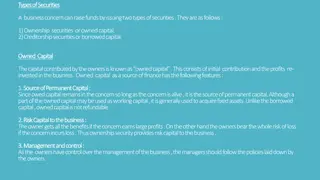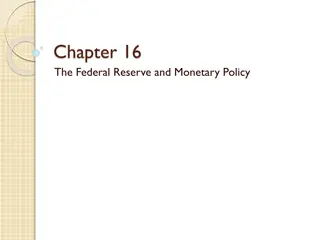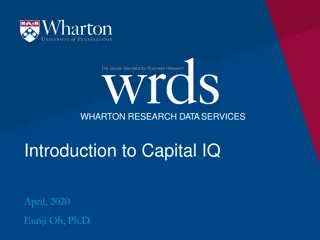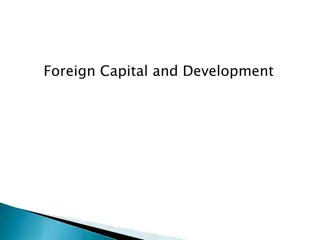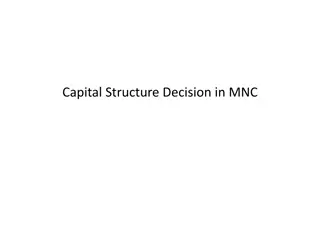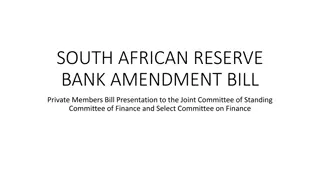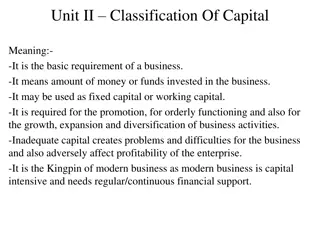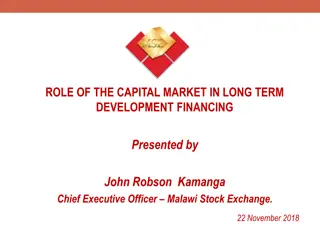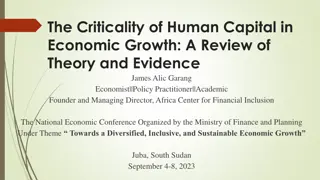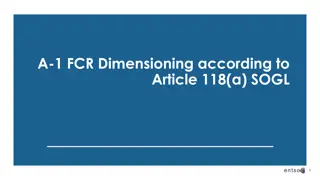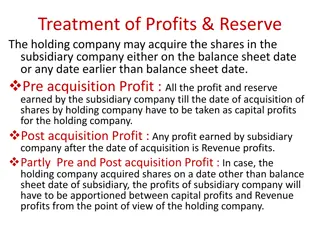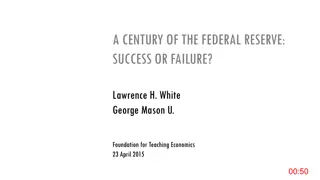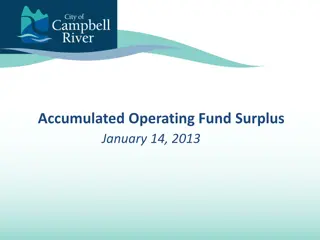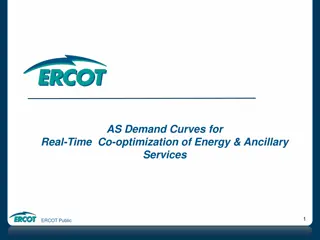CAPITAL STRUCTURE
Capital structure refers to the mix of a firm's capitalization, including debt, preference share capital, equity share capital, and retained earnings. Choosing the right components of capital is crucial based on the organization's function and risk level. Different patterns/forms of capital structur
1 views • 6 slides
Theories of Capital Structure and their Applications
The theories of capital structure explore the relationship between debt and equity in a firm's financing decisions. By optimizing the mix of debt and equity, a company can minimize its cost of capital and maximize its value. The Net Income Approach highlights the benefits of using debt to lower the
1 views • 7 slides
Factors Influencing Economic Growth: Human Capital and Capital Goods
Factors such as investment in human capital, capital goods, natural resources, and entrepreneurship play a crucial role in determining a country's economic growth. Human capital encompasses the skills and abilities of workers, while capital goods are the tools and equipment used to produce goods and
2 views • 28 slides
Aditya Birla Capital Scholarship for Classes 1 to 8.
The Aditya Birla Capital Scholarship is run by the Aditya Birla Capital Foundation and is designed to help students in Classes 1 to 12 and undergraduates with financial aid for their education. The program provides a one-time scholarship of up to INR 60,000 to cover academic expenses. \nTo Know More
0 views • 5 slides
Aditya Birla Capital Scholarship for Classes 9 to 12.
The Aditya Birla Capital Scholarship:\nThe Aditya Birla Capital Scholarship, run by the Aditya Birla Capital Foundation, aims to help students in school and college by offering financial aid and educational support. The scholarship provides up to INR 60,000 (one-time) for academic expenses, and st
1 views • 5 slides
Mutual Capital Investment Fund: Addressing Capital Needs in the Insurance Community
Mutual Capital Investment Fund, LLC, aims to provide capital to mutual insurance companies facing capital needs without converting to stock form or selling minority interests. Led by Mutual Capital Group, the Fund seeks commitments up to $100 million and offers a unique investment opportunity for mu
0 views • 8 slides
Types of Securities: Owned Capital vs Borrowed Capital in Business Financing
Owned capital, contributed by owners, provides permanent risk capital to a business with high returns but lacks withdrawal flexibility. Borrowed capital, obtained through loans, offers fixed-period finance with tax advantages and flexible repayment options, but involves fixed interest payments and i
1 views • 9 slides
Understanding the Federal Reserve System and Monetary Policy
Delve into the history, structure, and functions of the Federal Reserve System, including its role in implementing monetary policy to stabilize the economy. Explore the establishment of the Federal Reserve Act of 1913, the structure of the Federal Reserve, and its pivotal role in serving the governm
0 views • 35 slides
Understanding Fractional Reserve Banking Through Multiple-Choice Questions
Test your knowledge of fractional reserve banking with a series of questions covering topics such as its history, profit mechanisms for banks, the money supply, reserve requirements, excess reserves, and the impact of reserve ratio changes on the money supply. Explore concepts related to commercial
1 views • 12 slides
Understanding International Capital Structure and Cost of Capital
Explore the concept of international capital structure and its impact on the cost of capital, including discussions on cost of equity, investment decisions, market segmentation, and cross-border financing. Learn how firms can lower their cost of capital through internationalization strategies, such
0 views • 19 slides
Features of an Appropriate Capital Structure and Optimum Capital Structure
While developing a suitable capital structure, the financial manager aims to maximize the long-term market price of equity shares. An appropriate capital structure should focus on maximizing returns to shareholders, minimizing financial insolvency risk, maintaining flexibility, ensuring the company
3 views • 5 slides
Understanding Capital IQ: A Comprehensive Overview
Explore the world of Capital IQ through this detailed guide covering its history, products on WRDS, unique features, and comparison with other data services. Learn about the extensive financial information, real-time market data, structured datasets, and people intelligence provided by Capital IQ. D
0 views • 13 slides
Understanding Foreign Capital and Its Implications on Development
Foreign capital plays a significant role in the development of a country through investments from foreign governments, institutions, and individuals. It encompasses various forms such as foreign aid, commercial borrowings, and investments that contribute to capital formation, technology utilization,
0 views • 19 slides
Understanding Risk, Cost of Capital, and Capital Budgeting in Corporate Finance
Explore the concepts of risk, cost of capital, and capital budgeting in corporate finance, including the Capital Asset Pricing Model (CAPM), cost of equity, beta estimation, and cost of capital. Learn how to reduce the cost of capital and understand the impact of reducing the Weighted Average Cost o
0 views • 20 slides
Understanding Multinational Capital Structural Decision
Multinational corporations rely on capital to fund their expansion and projects. Capital structure decisions impact the cost of capital, profitability, and overall value. MNCs face complexities in balancing debt and equity for financing operations, choosing markets and currencies, and internationali
1 views • 37 slides
Demographic Human Capital DGE Model for High-Growth Scenarios in Rwanda
This study focuses on a Demographic Human Capital Dynamic General Equilibrium (D-DGE) model for analyzing high-growth scenarios in Rwanda from 2016 to 2050. It explores the interactions of demographic dynamics, human capital, public infrastructure, and debt within a long-term growth framework. The m
0 views • 28 slides
New Accession Training (NAT) & The Navy Reserve Program Details
Program Requirements designed to address critical Navy Selected Reserve manning shortfalls, including training pipeline details, drill pay structure, Montgomery GI Bill benefits, and Post 9/11 GI Bill qualification criteria for Reservists. The program aims to provide comprehensive training and benef
0 views • 27 slides
Presentation of South African Reserve Bank Amendment Bill to Joint Committee
The Economic Freedom Fighters (EFF) presented the South African Reserve Bank Amendment Bill to amend the current ownership structure allowing private individuals, including foreigners, to own shares in the South African Reserve Bank. The presentation emphasizes the need for legislative actions withi
0 views • 19 slides
Understanding the Classification and Importance of Capital in Business
Capital is crucial for businesses, whether for promotion, functioning, growth, or expansion. It can be classified as promotional, long-term, short-term, or development capital. Factors influencing capital requirements include business activity, size, product nature, technology, business cycle, and l
2 views • 13 slides
Role of the Capital Market in Long-Term Development Financing
The presentation by John Robson Kamanga, CEO of Malawi Stock Exchange, delves into the role of capital markets in financing long-term development. Topics covered include defining capital markets, functions of stock exchanges, development finance, areas funded by development finance, the capital mark
0 views • 23 slides
The Critical Role of Human Capital in Economic Growth: A Review
Literature highlights the significance of human capital formation in driving economic growth and achieving macroeconomic objectives. Human capital accumulation enhances productivity, reduces unemployment, poverty, and inequality, underscoring the need for investments in education, health, and job tr
0 views • 25 slides
Capital Gains and Assets Overview in Income Tax Law and Accounts
This content provides an overview of capital gains and assets in income tax law and accounts, covering topics such as types of capital assets, assets not considered capital assets, kinds of capital assets (short-term and long-term), transfer year of chargeability, computation of capital gains, and c
0 views • 15 slides
Understanding Recovery Support Services and Building Recovery Capital
Recovery Support Services (RSS) aim to help individuals bridge gaps and maintain long-term recovery by enhancing their Recovery Capital. These services provide resources in various life domains such as employment, housing, social support, and more. Recovery Coaches offer support at different stages
1 views • 10 slides
National Food Reserve Agency (NFRA): Enhancing Food Security in Nigeria
The National Food Reserve Agency (NFRA) under the Federal Ministry of Agriculture & Water Resources plays a crucial role in addressing agricultural production, storage, and marketing challenges in Nigeria. With a vision to ensure sustainable food access for all Nigerians and become a global food pro
1 views • 30 slides
Fiscal Year 2022 Capital Budget Presentation Overview
In the presentation to the Board of Finance, the Capital Committee outlines the Fiscal Year 2022 draft capital budget, emphasizing the importance of the Capital Improvement Program and the history of the capital program investments. The proposed budget addresses the critical need for reinvestment in
0 views • 11 slides
Understanding Financing Decisions and Capital Funding
Explore the world of financing decisions and capital funding through images and descriptions. Discover how financial systems function, estimate external funds for growth, and learn about debt vs. equity capital. Delve into corporate financing methods, sources of funds, and the importance of raising
0 views • 78 slides
The Legend of Sherwood Forest: From Royal Hunting Reserve to Nature Reserve
Sherwood Forest, once a royal hunting reserve in the 10th Century, is renowned for its association with the legendary figure Robin Hood. The forest provided cover for both hunting and outlaws, eventually becoming a nature reserve attracting millions of visitors annually. Despite its reduced size fro
0 views • 9 slides
RHD Cost Sharing Review Update 2010: Capital Planning Horizons and Funding Strategies
The RHD Cost Sharing Review Update in 2010 focuses on the status of implementing recommendations from previous reviews regarding capital planning and funding cycles for health authorities and Regional Hospital Districts. It discusses the impact of economic conditions on capital funding, availability
0 views • 11 slides
Development of Methodologically Robust Agricultural Capital Stock Statistics by FAO
In November 2015, the Food and Agriculture Organization of the United Nations (FAO) initiated a project to enhance Agricultural Capital Stock statistics, focusing on inclusive and efficient agricultural and food systems. The project involves developing methodologies for measuring capital stock and m
0 views • 38 slides
Estimating the Cost of Capital in Corporate Finance
Explore the process of estimating the cost of capital essential for discounted cash flows models in corporate finance. Learn how to determine the cost of debt, equity capital, and the Weighted Average Cost of Capital (WACC) by combining different sources of financing. Gain insights into capital stru
0 views • 59 slides
FCR Dimensioning Rules Proposal for Synchronous Area Operational Agreements
Article 118 of the Synchronous Operational Agreements introduces rules for the dimensioning of Frequency Containment Reserve (FCR). The proposal requires TSOs to jointly develop guidelines for FCR dimensioning, including annual reserve capacity determination and initial obligations. Specific criteri
0 views • 16 slides
Understanding Flight Attendant Reserve Rotation Process
Explore the basics of reserve rotation for flight attendants, including how to determine if you are on reserve, the impact of senior bump, and details of the rotational schedule for different years of service. Learn about when you will need to serve reserve, how the reserve list is generated, and ho
0 views • 12 slides
Understanding Treatment of Profits and Reserves in Holding Companies
The treatment of profits and reserves in holding companies when acquiring shares in subsidiary companies is essential for understanding the apportionment of pre-acquisition and post-acquisition profits. This involves distinguishing between capital profits and revenue profits, calculating the cost of
0 views • 8 slides
Understanding Net Investment in Capital Assets and Its Importance
Net Investment in Capital Assets is a critical component of an entity's financial position, reflecting the value of capital assets owned. It represents the portion of the net position that is not spendable as it is invested in assets. Calculating Net Investment in Capital Assets involves subtracting
1 views • 17 slides
Understanding Venture Capital: Key Concepts and Regulations
Venture capital is a form of financing provided to startup companies with high growth potential. It involves high risk and requires a long-term horizon, often coming in various forms like equity, conditional loans, and participation in management. The process includes stages such as seed capital, ex
0 views • 10 slides
Understanding Capital Adequacy Ratio (CAR) in Banking
Capital Adequacy Ratio (CAR) is a crucial metric in banking that measures a bank's capital against its risk. Also known as CRAR, it enhances depositor protection and financial system stability worldwide. The CAR formula involves dividing a bank's capital by its risk-weighted assets, comprising tier
0 views • 7 slides
Difference Between Capital Market and Money Market: A Comprehensive Overview
The capital market and money market serve different purposes in the financial world. While the capital market provides funds for long-term investments in securities like stocks and debentures, the money market deals with short-term borrowing and lending of funds. The capital market acts as a middlem
0 views • 4 slides
Evolution of the Federal Reserve System: A Century of Impact
Explore the establishment of the Federal Reserve, the role of the central bank in a free-market economy, pre-Fed era panics, policies affecting national banks, reform discussions, and the pivotal Federal Reserve Act of 1913, shaping the financial landscape of the United States.
0 views • 41 slides
Financial Policy Recommendations for Accumulated Surplus Management
The council policy recommends retaining an accumulated surplus up to 4% of operating expenditures, with any excess transferred to the Capital Works Reserve. The rationale behind this policy includes ensuring cash flow, setting aside funds for future expenditures, maintaining a rainy day fund, and pr
0 views • 14 slides
Real-Time Co-optimization of Energy & Ancillary Services Demand Curves
Explore the concept of constructing demand curves for Regulation Up Service, Regulation Down Service, and Responsive Reserve Service from the ERCOT public data. Learn about modifying individual AS demand curves and allowing overlaps to enhance co-optimization and efficiency. Dive into an example AS
0 views • 17 slides






